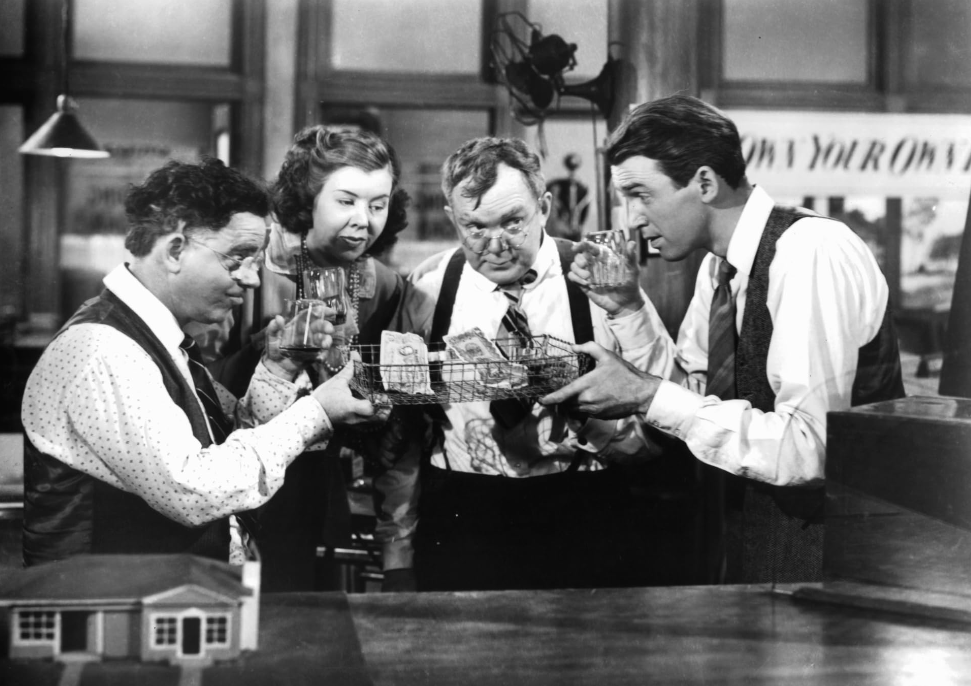It’s that time of year again. The networks, cable, streaming services and people’s personal DVRs will be burning the Yule Log Oil airing scores of classic holiday movies and TV shows. It’s a sure bet that It’s a Wonderful Life will be well represented.
Sure It’s a great movie and George Bailey is a wonderful character. But is he a good business person? Or even a good manager? I don’t think so. I watched the movie over Thanksgiving and here are some management and leadership lessons I feel we can learn from how George Bailey conducts his business affairs.
He hates his job.
This is at the core of most of George’s problems. He doesn’t want to have anything to do with the Bailey Building and Loan and it permeates every aspect of how he works, how he deals with his coworkers, his friends and even his family. He resents his responsibilities and obligations, longing for a life of adventure and freedom. George holds unrealistic expectations for his life, leading him to experience constant dissatisfaction and disappointment. This negativity prevents him from engaging in activities that could actually make the Building and Loan more successful and him happier.
The lesson: If you are miserable in your work, make a career change. Don’t just wallow in your misery. Move on. Self-sacrifice is a noble and admirable quality, but it’s also important to balance it by taking care of yourself and doing what’s right for you.
He’s a poor networker.
Throughout the film George constantly pushes the Sam Wainright character away when all that character wants to do is collaborate with him on projects that ultimately make Sam a wealthy man. He compares himself to Sam and is envious of his success and freedom. This envy blinds him to the opportunities collaborating with Sam will give him. By embracing Sam, George may have even been able to make the Building and Loan a more financially stable institution. That not only would have benefited him and his family, but the entire community of Bedford Falls as well.
The lesson: If you meet an industry colleague that makes you feel envious, it’s probably because they possess qualities that you lack. That actually makes them a great partner for collaboration. Don’t push them away — embrace them!
He’s a poor manager.
George’s main problem with managing his employees is that his hatred of the Building and Loan inhibits his ability to accurately assess their strengths and more importantly their weaknesses. He has three employees, yet he entrusts the very important job of making crucial bank deposits to the simple minded and forgetful Uncle Billy. There were two other more competent people that could have handled that responsibility.
The lesson: We all have strengths and weaknesses. When managing a staff, you should definitely groom them to improve their skills, but ultimately, put them in positions where they are more likely to succeed.
He’s unprofessional when it comes to handling business relationships.
This is actually where George’s life really goes off the rails. While the film portrays Mr. Potter as the antagonist, George Bailey could have potentially improved their relationship through various approaches:
Open Communication: George often avoids Mr. Potter, harboring resentment and suspicion. Instead, initiating open and honest conversations could have established clearer expectations and addressed any underlying issues.
Collaboration: Instead of viewing Mr. Potter as solely an adversary, George could have explored opportunities for collaboration. Mr. Potter’s business acumen and George’s understanding of the community’s needs could have resulted in mutually beneficial partnerships.
Respectful Disagreement: This is the biggie. George could have challenged Mr. Potter’s views and practices while maintaining respect and professionalism. Acknowledging Mr. Potter’s contributions while expressing concerns could have fostered a more constructive dialogue.
Focusing on Shared Goals: Both George and Mr. Potter desired the town’s prosperity, albeit with differing methods. Identifying and focusing on their shared goals, such as economic growth and community development, could have provided a foundation for cooperation.
Understanding Perspectives: George could have attempted to understand Mr. Potter’s perspective and motivations, recognizing that his actions, while seemingly antagonistic, might have stemmed from genuine beliefs or past experiences. This empathy could have fostered a more tolerant and collaborative relationship.
Seeking Common Ground: While their ideologies differed, there might have been specific issues or projects where they could have found common ground and worked together for the benefit of the community. This could have built trust and paved the way for further progress.
Avoiding Inflammatory Rhetoric: George’s public pronouncements criticizing Mr. Potter likely exacerbated their already strained relationship. Instead, employing a more diplomatic approach, focusing on solutions rather than accusations, could have opened up possibilities for dialogue.
Accepting Differences: Recognizing that Mr. Potter might never share his values or beliefs, George could have focused on accepting their differences and finding ways to coexist peacefully and operate within their respective spheres of influence.
Promoting Harmony: Ultimately, George could have aimed to promote harmony and cooperation within the community, recognizing that Mr. Potter, despite their differences, was also a member of Bedford Falls. This broader perspective could have led to a more peaceful and productive environment for everyone.
The lesson: In the world of the movie, it’s important to note that these are theoretical approaches, and their success would have depended on Mr. Potter’s willingness to reciprocate. However, by implementing these strategies, George might have created a more positive and collaborative relationship with Mr. Potter, potentially leading to better outcomes for both the Building and Loan and the community as a whole.
But in real life, when dealing with difficult people in your professional orbit, avoid George’s crash and burn strategy.
Any thoughts, opinions, or news? Please share them with me at vince@meetingsevents.com.





